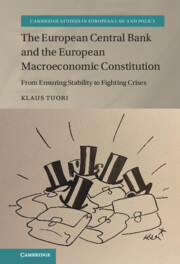 The European Central Bank and the European Macroeconomic Constitution
The European Central Bank and the European Macroeconomic Constitution from Part II - Crises, ECB Measures and the Macroeconomic Constitution
Published online by Cambridge University Press: 15 September 2022
The chapter analyses how the ECB was granted responsibility over prudential supervision as part of the EU banking union. This changed the EU perspective on financial services from internal market issue to a macroeconomic financial stability issue. The ECB now supervises directly the largest banking groups in the euro area and monitors the supervision of all other banks as well. The ECB’s role in the banking union raises new types of constitutional questions and requires a different analytical framework. A formal legal assessment, particularly on the legal basis for conferring specific tasks on the ECB under Article 127(6) TFEU, is complemented with a broader economic constitutional analysis. Here, the context in which the banking union was initiated is particularly important. The chapter also discusses the merits and caveats of combining banking supervision and monetary policy, where the conflict of interest is the main caveat particularly for an independent institution such as the ECB. It is also concluded that the supervision could return to the internal market setting and again be separated from monetary policy in the future.
To save this book to your Kindle, first ensure [email protected] is added to your Approved Personal Document E-mail List under your Personal Document Settings on the Manage Your Content and Devices page of your Amazon account. Then enter the ‘name’ part of your Kindle email address below. Find out more about saving to your Kindle.
Note you can select to save to either the @free.kindle.com or @kindle.com variations. ‘@free.kindle.com’ emails are free but can only be saved to your device when it is connected to wi-fi. ‘@kindle.com’ emails can be delivered even when you are not connected to wi-fi, but note that service fees apply.
Find out more about the Kindle Personal Document Service.
To save content items to your account, please confirm that you agree to abide by our usage policies. If this is the first time you use this feature, you will be asked to authorise Cambridge Core to connect with your account. Find out more about saving content to Dropbox.
To save content items to your account, please confirm that you agree to abide by our usage policies. If this is the first time you use this feature, you will be asked to authorise Cambridge Core to connect with your account. Find out more about saving content to Google Drive.